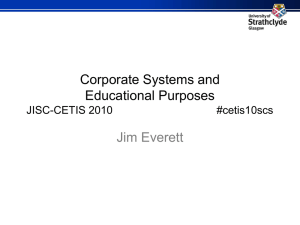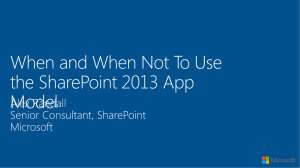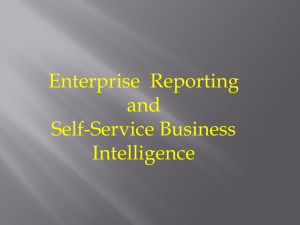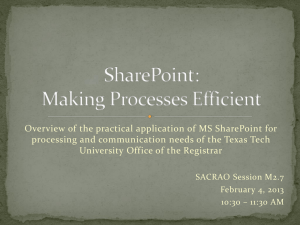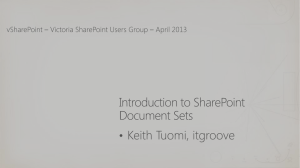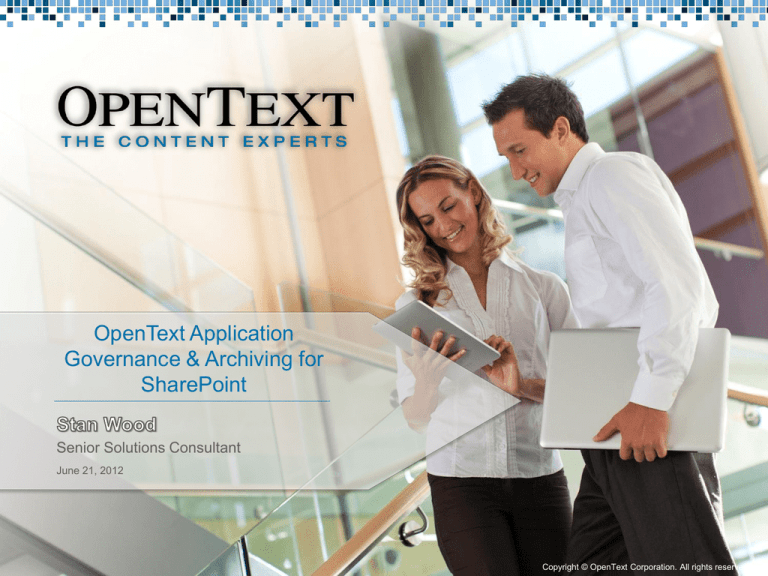
OpenText Application
Governance & Archiving for
SharePoint
Senior Solutions Consultant
June 21, 2012
Copyright © OpenText Corporation. All rights reserved.
Agenda
About OpenText
Product Portfolio Overview
OpenText, Microsoft Partnership
Information Governance for SharePoint
What you should be asking…
The Ideal
Solution Overview
Discussion
Who is Open Text?
Founded 1991
Largest Independent ECM Vendor
More than 3,500 staff globally
The safe choice for your ECM strategy and investments
Publicly Traded: NASDAQ, TSX
FY2011: Revenue > $1 billion
23% Global Market Share
46000+ Customers
Consistent ECM market visionary
Copyright © Open Text Corporation. All rights reserved.
Slide 3
History of Innovation
&First: SGML-aware search engine
&First: search-engine provider to Yahoo and Netscape
&First: to OEM Netscape’s Web Server for dynamically assembled HTML
&First: to develop archiving for SAP transactional content
&First: to deliver “integrated document management” that seamlessly integrated
document management and workflow into collaborative spaces
&First: WYSIWYG web content management
&First: to treat real-time meetings as persistent
collaborative content
&First: ECM vendor to develop SharePoint-
based applications (i.e., not just Web parts)
&First: ECM vendor on SAP’s reseller price list
&First: ECM vendor to receive highest
partnering honors from both SAP and
Microsoft
Copyright © Open Text Corporation. All rights reserved.
Slide 4
Portfolio: Enterprise Content Governance Cloud
Content Sources
Mobility
Departmental Content
Repositories
Shared and Local
Drives
Digital Media
Premises or Cloud Based
ECM Cloud
OT
Collaboration
OCR/ICR
Forms
SharePoint
Services
SAP Business
Suite Apps
BPM
Automated
Classifications
Exchange
Services
SAP ECC
OT Media
Management
WEB Content
Management
Search
SharePoint
Server
Integration Services
Records Management
Metadata
Archive & Storage Management
Exchange
Server
SAP
NetWeaver
Archiving and RM Services for the Enterprise
Massively
Scalable
Archiving Server provides certified and
endorsed content and data archiving for
SharePoint
Exchange
Lotus
File System
SAP
Enterprise Library
Single Instance
Compression
Copyright © Open Text Corporation 2009 - 2010. All rights reserved.
Encryption
Search
Slide 6
Open Text and Microsoft… Better Together!
Long term, close partnership
70,000+ Microsoft ISV’s
150 Microsoft
Global ISV’s
Selected by Microsoft
as 1 of 30 Strategic ISV’s
Microsoft Executive Sponsor:
Jeff Teper, Corporate Vice
President SharePoint
Dedicated Microsoft Business
Unit, Executive Sponsor James
Latham, CMO
Support across multiple products
and Industries
Joint sales, product development
& marketing
Joint Product
Activities
www.bettertogethercentral.com
8
SharePoint is here…
Sources: “State of the ECM Industry 2011,” AIIM, March 2011; “Microsoft TechNet,” Microsoft, February 9, 2011
CONTENT
So what are we using SharePoint for?
Source: “SharePoint Industry Watch,” AIIM, July 2010
Information Governance
ECM/
Records
Management
Search/
eDiscovery
Information
Governance
Archival/
Storage
Management
Source: “The Rise of Information Governance,” The451 Group, August 2009
Considering Information Governance for SharePoint?
How much content do you have?
What types of content do you have?
Can you maintain the experience?
What are your compliance requirements?
Who will be using SharePoint, and how?
How long do you plan on keeping your content?
In SharePoint…
In your company…
What version of SharePoint do you have?
Considering Information Governance for SharePoint?
How much content do you have?
20 Exabytes
5 Exabytes
IDC research shows that enterprises are
2015
increasing the size and scope of their
2011
collaboration environments, with SharePoint
emerging as a major driver of information
growth.
Source: “The Digital Universe Decade – Are You Ready?,” IDC, May 2010
Considering Information Governance for SharePoint?
How much content do you have?
Considering Information Governance for SharePoint?
What types of content do you have?
Considering Information Governance for SharePoint?
Whatcontent
types ofdo
content
do you
have?
What
you want
to access?
Considering Information Governance for SharePoint?
Can you maintain the experience?
Considering Information Governance for SharePoint?
What are your compliance requirements?
Considering Information Governance for SharePoint?
Who will be using SharePoint, and how?
Considering Information Governance for SharePoint?
How long do you plan on keeping your content?
Active
Inactive
of SharePoint sites
within an organization
are orphaned or inactive
You need to ask yourself:
Is SharePoint the most cost effective place to store inactive content long term?
Source: “Gathering MOSS? Revealing SharePoint Opportunities and Cost,” InfoTrends, August 2009
WARFIGHTER-FOCUSED, GLOBALLY RESPONSIVE, FISCALLY RESPONSIBLE SUPPLY CHAIN LEADERSHIP
Enterprise Content Management Drivers
• Growth of unstructured content
• Inability to find and re-use relevant content
• Content fragmented across application and
content silos
• Excessive time is spent on searching for
information
• Need for long-term preservation and legal
compliance
WARFIGHTER SUPPORT ENHANCEMENT
STEWARDSHIP EXCELLENCE
WORKFORCE DEVELOPMENT
23
WARFIGHTER-FOCUSED,
WARFIGHTER-FOCUSED,GLOBALLY
GLOBALLYRESPONSIVE,
RESPONSIVE,FISCALLY
FISCALLYRESPONSIBLE
RESPONSIBLESUPPLY
SUPPLYCHAIN
CHAINLEADERSHIP
LEADERSHIP
ECM benefits - save time/improve business efficiencies
• Certified solution adhering to U.S. DoD 5015.2
• Supports FIAR objectives, eDiscovery, research and business
activities.
• Easier access to all records types (existing SAP archive,
SharePoint documents, and MS Exchange)
• Architecture rationalization – simplified management & operations
• Migrating from highly customized application
COTS architecture and scalability – OpenText
tightly integrated with SAP and Microsoft
• Storage optimization through de-duplication
and compression
WARFIGHTER SUPPORT ENHANCEMENT
STEWARDSHIP EXCELLENCE
WORKFORCE DEVELOPMENT
24
What’s the Ideal?
Centralized Governance:
Ensuring that all of your organizations content,
including SharePoint is managed centrally under a
unified set of policies
Taking measures to ensure that SharePoint site
creation is being managed and aligned to policy
Optimization/Performance:
Redirecting active SharePoint content to optimize
SharePoint performance and meet back-up
windows
Long Term Preservation
Archiving old and inactive SharePoint content to offset storage costs and ensure compliance
End-user Transparency
Making sure end-users have access to all content
through SharePoint
Ensuring the “experience” is never affected
Lifecycle applications address
, and rising
costs in accordance with your
practices.
File System Archiving
Legal Content
Management
Correspondence
Tracking
Email Archiving/Mgmt.
Email Monitoring
Application Governance
& Archiving
Storage Services
26
Agenda
About OpenText
Product Portfolio Overview
OpenText, Microsoft Partnership
Information Governance for SharePoint
What you should be asking…
The Ideal
Solution Overview
Discussion
AG&A for SharePoint – 3 functional areas
Web Parts and content specific SharePoint pages that
allow users to search and work with Content Server
items, including ERP, email, FSA.
Interactive and/or manual site retirement
Deploy sites with predefined policies which utilize
OpenText Content Management features – RM,
permissions, storage etc.
Architecture
Site Deployment Support for SharePoint
SharePoint
Administrator Tools
Transparency
Search
Retention
Policy
Governance
Archiving
&
Compliance
Project Sites
Scanning
Metadata
Mapping
Auditing
SharePoint Site Deployment
Site Types/ Site Groups
Deployment Console
Execution Engine
Property Inheritance
Automatic Document/Site
numbering
CLM Integration
preconfigured in Site Profiles
Content Lifecycle Management for SharePoint
End User Tools
Lifecycle
eDiscovery
Content
security
Document
Archiving
management
Scanning
Digital asset
management
Auditing
Records
management
Lifecycle SharePoint
Content
Interactive/Automatic
Document Archiving
Site Archiving
Records and Information
Management
Content Server User
Interface
Browsing the Content Server
Work in SharePoint with
Content Server items
Search Content Server items
Copyright © Open Text Corporation 2009 - 2010. All rights reserved.
Slide 31
OpenText Site Deployment
What SharePoint offers out of the box
Site Templates
List Templates
Content Types
What OpenText customers are requesting
Automated/Simplified site creation process
Automatically created sites should already have all needed
functionality, e.g. SharePoint Features, Document Libraries,
folder strutures, security settings to support governance.
Collect and store metadata with SharePoint site
Central place to keep track of all SharePoint sites in a farm
OpenText Site Deployment Provides
Site Metadata
Define metadata structure for a new site
Leveraging standard SharePoint Content Types
Site Types
Generalized „Site Templates“
SharePoint Template + Feature Activation + Metadata Structure
+ Folder Structure + Lifecycle Workflows + Site Archive Profiles
Site Groups
Site Types assigned; customizing Site Types
Create/Manage sites per departement or business solution
Execution Engine
Dynamic script actions for site creation
Solution
Site Deployment
Console
Site Group
Define the behavior/lifecycle of
Self
Service
for
department-specific
site
Important
content
of outdated sites
Create
Sites
SharePoint sites in the
creation
archived Manage
and sites(Site
deleted
automatically
SiteGroups)
Site Deployment
console
Lifecycle
Define Site
Metadata
Define Site Types
Create Deployment
Scripts
Create Site Groups
.
.
.
Deployed Sites
Site Deployment Console
Sites with Metadata
Sites with Metadata
Site Types, beyond Metadata
SharePoint
Template
Metadata Schema
Folder Plan
Access Control
Feature Activation
Parent Site
Archiving Profile
Workflows for all
Lifecycle steps
Site Group Console
Benefits for SharePoint Administrators
Site creation can be completely automated, including
approval workflows
Created sites already include OpenText functionality, no
manual configuration after site creation
Sites with built-in lifecycle can be created
Predefined steps discerning when a site can be destroyed are
set in place when the site is created
Important content archived before sites are
automatically deleted
Deleted sites can be restored when needed
Business Issue
Managing Enterprise Records with one set of policies
and schedules
Ensure capture, preservation, and defensible disposition of
enterprise content stored in SharePoint
One central Records Management program is needed for all
enterprise content
Adhering to external regulations and internal policies
Intuitive and flexible classificiation of content
Comply with worldwide standards and certifications
Litigation Readiness
Being prepared for eDiscovery
Solution
Business content (records
and non records) created in
SharePoint is classified into
the Enterprise Library
Interactive/automatic
classification supported
Web Parts/SharePoint pages
allow users to browse/search
for business content
(electronic and physical)
SharePoint
Classification of
business content
Enterprise Library
Benefits for SharePoint Users
New
SharePoint
sites have
already
built-in
Retention or
&
Flexible
classification,
e.g.,
browsing
classifications
Disposition
process
Automatic
deletion
of
orphaned
links
Classified
content
is
automatically
updated
with
business
Documents,
folders,
and
sites
can
be
classified
ManageManagement
classified content
in place
Records
functionality
pick list metadata
of recently
used classifications
specific
(content
type mapping)
Benefits for SharePoint Users
Requesting, borrowing
creating
flag
for pickup
on
Browsing/searching
for and
electronic
and
physical
Records
items.
fromphysical
within SharePoint
Using SharePoint as a portal to access
enterprise content
Business Issue
Accessing enterprise content through a SharePoint
portal – e.g. intranet portal
Content Server contains important enterprise content, is used as
corporate memory
Browsing Content Server items
Searching for Content Server items
Avoid content duplication by exposing enterprise
content within SharePoint
Solution
Expose Content Server
items with the Enterprise
Library Web Part
Display other Content
Server information with
LiveReports (Generic
Web Part)
Benefits for SharePoint Users
Content
Server
exposed
in SharePoint
portals
in the
Content
Serveritems
functionality,
e.g.,
version
history,
audit
Uploading/creating
new
content
from
within
SharePoint
Full page view for
Content
Server
items
available
same waymetadata
as native
SharePoint Items
information,
information
available
supported
Exposing and managing business relevant
emails in SharePoint
Business Issue
Standard Outlook®/Exchange/SharePoint does not
provide Email Management capabilities like:
Options to classify content
Drag & drop from Outlook to SharePoint
Email management assistant
Tamper-proof and cost-effective long-term
storage
Automatic PST Ingestion
Solution
Email Archiving
Email Management
Email Monitoring
Capture emails,
e.g. Enterprise Connect
Enterprise Library
Deploy SP Sites
with access to
managed emails
SharePoint
Solution - Accessing managed emails in SharePoint
Benefits for SharePoint Users
Users
see managed emails in SharePoint together with
other SharePoint content.
E.g., in a SharePoint site used for project
management you can access all managed emails
related to the project.
properties, e.g., “From”, “Subject”, and
“Received” are displayed.
Email-specific
Managed
personal emails can be accessed from
SharePoint “MySites”.
Managed
emails can be copied into SharePoint
document libraries or links can be created.
Decomissioning file shares while accessing
and working with legacy content through
SharePoint
Business Issue
Microsoft recommends:
Users should to stop working with File Shares and start
working with SharePoint
Huge amounts of data on File Servers
Large percentage of content is duplicates
Even if you migrate only a part of the documents to SharePoint,
this would be still a lot of data
In standard SharePoint it is cumbersome to store all this
data:
Potential need for many content databases
Expensive SQL Server storage needed
Solution
File Server
Archive
(Move)
Enterprise Library
Deploy SP Sites with
access to archived
File System content
SharePoint
Benefits for SharePoint Users
Users can still access their old file system content when
they start working with SharePoint
New SharePoint sites already have access to the old
file system content (no manual configurations needed)
Migrated file system content:
Permissions still in place
Original folder structures still in place
Users can copy needed documents/folders selectively
into SharePoint document libraries or create links there
Storing SharePoint content on less
expensive storage media
Business Issue
Standard SharePoint stores all document content inside
the SharePoint SQL databases
Document I/O consumes a lot of SQL Server CPU and memory
More expensive SQL Server hardware needed
IT operations time & expense
A lot of expensive SQL Storage (SAN) required
Database administration costs are higher
Solution
SQL Server
Database
SharePoint
SQL Server
Database
Open TextContent
Storage Services
OpenText
Services
Enterprise Disk Systems
Benefits for SharePoint Administrators
Easier SharePoint Database Management
Less Content Databases needed
Shorter backup/restore times
Easier Site Collection Management
The content of a single site collection can be any size
No need to split up existing site collections
bettertogethercentral.com
Southeast Water
Marathon Oil
Biomedical Systems
Hydro One
Baker Donelson et al PC
Central Vermont Public
Service
Georgia systems
Operations Company
Forrester Report
Copyright © Open Text Corporation
Slide 62
Agenda
Discussion



